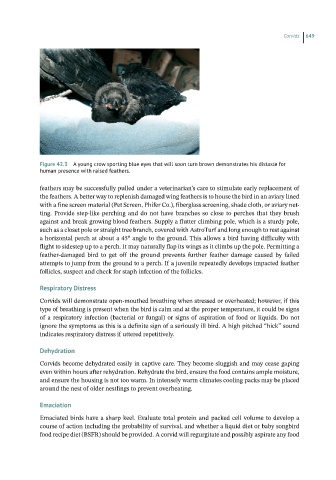Page 648 - Hand rearing birds second
P. 648
Corvids 649
Figure 42.3 A young crow sporting blue eyes that will soon turn brown demonstrates his distaste for
human presence with raised feathers.
feathers may be successfully pulled under a veterinarian’s care to stimulate early replacement of
the feathers. A better way to replenish damaged wing feathers is to house the bird in an aviary lined
with a fine screen material (Pet Screen, Phifer Co.), fiberglass screening, shade cloth, or aviary net-
ting. Provide step-like perching and do not have branches so close to perches that they brush
against and break growing blood feathers. Supply a flutter climbing pole, which is a sturdy pole,
such as a closet pole or straight tree branch, covered with AstroTurf and long enough to rest against
a horizontal perch at about a 45° angle to the ground. This allows a bird having difficulty with
flight to sidestep up to a perch. It may naturally flap its wings as it climbs up the pole. Permitting a
feather-damaged bird to get off the ground prevents further feather damage caused by failed
attempts to jump from the ground to a perch. If a juvenile repeatedly develops impacted feather
follicles, suspect and check for staph infection of the follicles.
Respiratory Distress
Corvids will demonstrate open-mouthed breathing when stressed or overheated; however, if this
type of breathing is present when the bird is calm and at the proper temperature, it could be signs
of a respiratory infection (bacterial or fungal) or signs of aspiration of food or liquids. Do not
ignore the symptoms as this is a definite sign of a seriously ill bird. A high pitched “hick” sound
indicates respiratory distress if uttered repetitively.
Dehydration
Corvids become dehydrated easily in captive care. They become sluggish and may cease gaping
even within hours after rehydration. Rehydrate the bird, ensure the food contains ample moisture,
and ensure the housing is not too warm. In intensely warm climates cooling packs may be placed
around the nest of older nestlings to prevent overheating.
Emaciation
Emaciated birds have a sharp keel. Evaluate total protein and packed cell volume to develop a
course of action including the probability of survival, and whether a liquid diet or baby songbird
food recipe diet (BSFR) should be provided. A corvid will regurgitate and possibly aspirate any food

